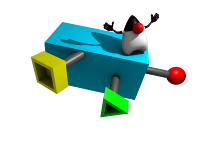Structure of the documentation
Design documentation is provided to illustrate different aspects of the
software. Each design document has the following structure:
- Introduction: A short introduction into the
functionality and why it is necessary
- Requirements: Outlining the basic requirements
- Design: Describing the overall solution principle and basic ideas
without mentioning classes, only the functional solution.
- Structure: Describes relevant class diagrams.
- Dynamics: Describes the most important scenarios to illustrate the
dynamic behavior of the system.
- Design Rules: Describes the main attention points
when using the described designs, something like the highlights of
the user manual of the design
Available Documentation
The following design documentation is available:
- Framework documentation: Documentation of the generic frameworks used.
- Application documentation: General design of the application itself and a description of
how the frameworks were used.
Framework Documentation
-
Caching: Explains the caching
support utilities used for application-level caching.
-
Persistence:
Explains the persistence support utilities to make Hibernate persistence
easier to use.
-
Concurrency:
Explains concurrency support.
-
Security: Explains the security
requirements and how they are realized.
-
User Management: Explains user management
design.
Application Documentation
Architectural Roadmap
- Use of a generic authorization mechanism to restrict access to photo albums based on user identity.
- The current implementation of the photo albums is done directly on a file system.
This will move to an implementation where the albums are maintained in a database
together with metadata for the photos and albums. The current implementation will just
become a storage bin for photos. This is because it is convenient to have direct
access to photos and because storing photos as big binary objects in a database is
generally not that efficient.
- Concurrency for photo albums is implemented using standard JVM locking. Concurrency
will also be delegated to the database to make it ready for clustered environments.
-
Use of a workflow engine. This is required for screen navigation (Tapestry does not really
provide anything, although Struts like navigation can be done in Tapestry) and for other
tasks such as online registration.
- More strict separation of presentation and business tier. Currently, the photo album
API is used directly in the presentation layer and this can encourage the implementation
of 'business functionality' in the presentation tier, which is not desired.
